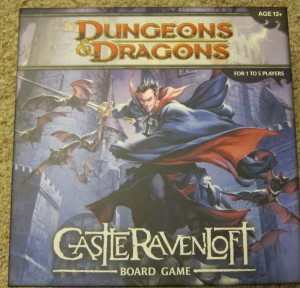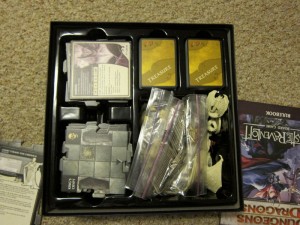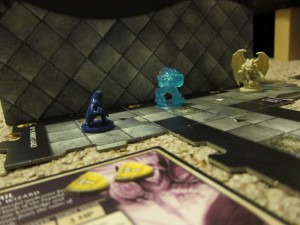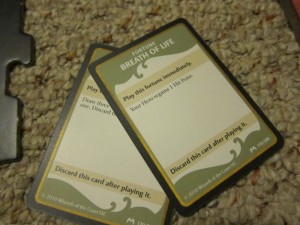 Second (or maybe equal) to my love of RPGs is my love of board games. When these two worlds intersect, it is a time of joy for me. I keep games like Hero’s Quest, Runebound, and Descent on standby. Like those games, Castle Ravenloft is about exploring a dungeon with fantasy-themed characters in order to kill monsters and obtain treasure. I’ve had the game for a month now, and plenty of opportunity to play it. The best parts of the game are that it approximates D&D 4e combat/movement mechanics and that it supports 1 to 5 players, which means that there opportunity for solo play, when you have a random half hour to game.
Second (or maybe equal) to my love of RPGs is my love of board games. When these two worlds intersect, it is a time of joy for me. I keep games like Hero’s Quest, Runebound, and Descent on standby. Like those games, Castle Ravenloft is about exploring a dungeon with fantasy-themed characters in order to kill monsters and obtain treasure. I’ve had the game for a month now, and plenty of opportunity to play it. The best parts of the game are that it approximates D&D 4e combat/movement mechanics and that it supports 1 to 5 players, which means that there opportunity for solo play, when you have a random half hour to game.
Unboxing
The game box is huge and heavy, but thankfully it’s tall rather than long… which means its fits on my shelves. Inside the box are a ton of cardboard punch outs with the tiles, character and monster cards, condition tokens, hit point tokens, and lots of various cardboard trackers and bits and bobs for the specific scenarios. There’s several decks of cards which represent the random monsters, treasure, and events. And of course a pile of single-color, but color-coded minis. The minis are are of decent quality, but in some ways i’d prefer if the game were $10-15 more expensive with nice looking minis. On the plus side it’s easy to find them in big box by searching for color (gray for undead, red for normal monsters, blue for heroes, etc). The big mini is a dracolitch, which I think I will use in regular D&D play as well. Although the game can take an hour to play, it can take 10 – 15 minutes to set up,in terms of stacking out the cards, sorting the tiles, and finding all the right cardboard tokens for the scenario. I’ve put my tokens into small snack baggies to keep them more organized.
Basic Play
The game is a very light version of a 4e delve. Each player takes one of 5 iconic characters (eladrin wizard, dragonborn fighter, dwarf cleric, human rogue, human ranger). Each character can choose a daily, utility, and two at-will powers from a small set of power cards based on the class and race of the character. The rules come with starter suggestions, but allow advanced players to choose their powers. I think the way these characters are distilled from the essentials will make it easy to introduce new powers or characters through expansions or your own creativity.
The game itself is pretty similar to Munchkin: kick down the door, fight the monster, get the treasure. On your turn you get a move and an attack action. If there are no monsters, you move to the edge of the tile. You then flip over a random tile (or a specific one depending on the scenario). The tile is then populated with a random monster. After that one usually pulls a random event card. These events are mostly effects that that either hurt you and your allies (generally by doing 1 damage) or a general effect that can effect allies and monster (like everyone gets extra damage on a roll of 18-20). After this you get to play all the still-living monsters you’ve uncovered. The monster cards have tactics to follow, which are generally move to the nearest guy and attack, or use a ranged attack. That’s pretty much it. The game continues with each player doing this until the party dies or completes the scenario objective.
Death and Dying
Cooperative board games are supposed to be hard, if you win every time it’s looses its fun, and Castle Ravenloft is no exception. It took me six tries to get through the first solo adventure and I haven’t beaten the first group adventure yet. Every turn you’re likely to take 2-3 damage (1 from the environmental effect or trap) and 1-2 from a Monster (the have a 50%-66% chance to hit on average). Since characters only have 6-12 hp, you can run out of hit points pretty fast. There’s a pool of 2 healing surges for the party. Once you go down to 0 hit points, you can use one of those surges on your turn to get back half your hit points. Once a character goes down to 0 for a third time, the game ends for everybody. While this might seem unfair, it’s well designed because it provides incentive people to work together, share resources, and doesn’t force a player to sit around while everyone continues the game. To make the game easier, the rules suggest adding an one or two more healing surges. The paths that lead to winning usually involve a bit of luck: e.g. pulling out encounter cards that don’t deal damage, getting treasure that restores hit points or surges, or being lucky with die rolls. Although it seems quite random and fatalistic, there is a fair amount of strategy in choosing powers, directions to explore, or pushing your luck against traps and monsters.
Monsters and Sweet Loot
Dungeon exploring is killing monsters and taking their stuff. There’s no shortage of that in Castle Ravenloft. The monsters appear at least once per tile, and most can be killed in one or two hits. The instead of normal blast/burst/range mechanics, you can either target an adjacent enemy, one or more enemies on your tile (think of it like a burst 5), or enemies on a certain number of tiles away (like a ranged 10 attack). Because you still move by squares but target actions by tiles, it’s a little more confusing than it ought to be, and the whole tile-area of effect mechanic may be the hardest thing for an experienced 4e player to wrap one’s head around. Also monsters tend to have actions like “move one tile” but there’s not a lot of guidance as to where in that tile it should be placed (nearest square, adjacent to any/nearest character, etc). There’s some suggestions on Board Game Geek around this. My house rule is that when something moves by tile, it is placed next to the nearest character, in the case of a monster, and closet safe square, in the case of a character. Once you kill a monster, you gain it’s card (which is worth 1 or more XP) and a random treasure. The XP are party resource and can be spent 5 at a time to either ignore an encounter card, or in conjunction with a natural 20, to level up.
Leveling Up
Leveling up is the probably the best move you can make in the game. You get extra hit points, improved armor and attack bonus, and an extra daily. The increased stats make a big difference in survivability. The only time I’ve beaten the game I attribute to gaining the extra level early on.
Final Thoughts
The game is a lot of fun, and surprisingly well designed. I’ve played some of the older D&D board games that have come out over the years, and those have always felt frustratingly ill-designed. Castle Ravenloft is a lot deeper than Hero Quest, without having complex rules of regular D&D. In fact the rules are my biggest complaint, or rather the rule book–there’s a lot of situations not covered, that should be solved by a 15-question FAQ. Also I haven’t discovered usages for about half the cardboard bits just by reading the rulebook and scenario book. Despite that shortcoming, it’s now my favorite way to get in a D&D fix when I have only an hour or less than a full compliment of players.
For further review, check out this Castle Ravenloft Review on RPG Digest. And if you’re ever in the greater Boston area and want to play a game, let me know!




Played a couple of games last night (just over the border in NH). It was a lot of fun. Played with 2 of us and then we played a 3 person when my wife got home.
The ranger seemed OP but it helped us to finish the 3rd scenario.
I really like the cooperative play, challenge and the balance of the game. Also I am running two 4E campaigns right now, but I haven’t had a chance to be a 4E player yet. This helps to fulfill that desire.
This is a great write-up! I’m tempted to pick this game up now.
I think the review is great. It does what a review should: Inform my decision as to whether or not to invest any time or money in the activity presented. Thanks, Mike. I’ll probably be picking this up before long.
I’ve played this a few times now and it’s awesome. I agree with your point about the rulebook needing an FAQ. Adventure 4 for example was worded very poorly, and if you interpreted it a certain way (as we did) it made the adventure almost impossible to complete.
Still, aside from this a brilliant game, cheers for the review.